Airfix 1/48 Spitfire FR XIV as an FR 18
It's a strange but interesting fact that the only "built for that specific powerplant" Spitfire to achieve a large production run was the Mk.I; while there were several other Marks specifically designed to make maximum benefit of the additional power of the later Merlins and then the Griffons, in each case the "interim" type cobbled together to bring the additional performance operational as soon as possible was the version that saw the most widespread production. This began with the Mk.V, which was essentially a beefed-up Mk.I airframe to take advantage of the Merlin 45's additional 400 h.p. This was followed by the Mk.IX, a beefed-up Mk.V to take advantage of the Merlin 60 series while the Mk.VIII was being designed to take maximum advantage of this engine. The last was the Mk.XIV, a beefed-up Mk.VIII airframe to use the Griffon.
The Type 394 Spitfire Mk. XVIII bears the same relationship to the Spitfire XIV that the Spitfire VIII bore to the Spitfire IX: designed to use the particular engine to best advantage, yet not produced in numbers approaching the "interim" type. This type introduced a new wing which was specific for the "E" type armament, rather than the "universal" wing used since the Spitfire Vc. Originally, the aircraft used the same Griffon 65 as the Spitfire XIV, but the Griffon 67 - which offered an additional 300 h.p. - was quickly introduced.
The Spitfire XVIII appeared just too late for use in the Second World War, with the first delivered to the RAF on May 28, 1945; as a result, only 300 F.Mk.XVIIIs and 200 F.R.XVIIIs were produced. The majority of the pure fighter variants were delivered to maintenance units and never saw operations, while the F.R.XVIII was delivered to two squadrons in the Middle East (32 and 208 Squadrons) and two squadrons in the Far East (28 and 60 Squadrons). The Spitfires of 32 and 208 Squadrons saw considerable action in the unstable immediate post-war years in the Middle East involving the end of the British Mandate and the Israeli War of Independence in 1948. Beginning in 1949 in Malaya, 28 and 60 Squadrons flew combat operations against communist terrorists in the colony, with the last operational Spitfire combat strike by a 60 Squadron aircraft occurring on January 1, 1951.
The Mk.XVIII had to be handled with respect by its pilot on takeoff, as was common with all Griffon-powered Spitfires with the 5-blade prop - even with full rudder applied, it was not possible to hold the aircraft straight with full power applied, and pilots generally took off using 2/3-3/4 power. Once airborne, the automatic throttle and boost setting control made aerobatics easy, and the Spitfire XVIII was completely viceless.
Combat in the Middle East:
208 Squadron was the first squadron to receive the FR 18 (as it was newly-designated), in August 1946. The squadron was based at Ein Shemer. The next month, 32 Squadron, based at Ramat David outside Haifa began replacing its Spitfire Ixs with FR 18s. Both squadrons were used to provide air cover to convoys moving around the troubled countryside. Both squadrons moved from Palestine to Nicosia, Cyprus, in March 1948, but used Ramat David for policing patrols.
The State of Israel was proclaimed on May 14, 1948, and immediately came under attack from the bordering Arab states. Just after dawn on May 22, two Egyptian Air Force (REAF) Spitfires of 2 Squadron REAF attacked the RAF detachment at Ramat David, destroying two and leaving eight damaged from strafing. They returned an hour later and shot down an RAF Dakota that was landing, and destroyed one of the damaged Spitfires. Two Spitfires of 208 Squadron were on standing patrol, and both Egyptian Spitfires were shot down, one exploding when it hit the ground since it was still carrying a bomb. A third REAF Spitfire was shot down by AA. Two hours later, a third attack was met by a standing patrol of two Spitfires from 208 Squadron. Flying Officer Tim McElhaw shot down two. The following day, the remaining RAF Spitfires were withdrawn to Cyprus, where 32 Squadron re-equipped with Vampires in July.
The last air combat the Spitfire ever engaged in involved Spitfires on both sides! On January 7, 1949, four Spitfires of 208 Squadron flew a reconnaissance mission over the Sinai. Two were hit and damaged by AA from the Israeli armored column they spotted, forcing Pilot Officer Close to bail out, while the other two were attacked by IDF Spitfire IXs of 101 Squadron, flown by American soldier-of-fortune Chalmers “Slick” Goodwin and 14-victory RCAF ace John McElroy, who made quick work of FR 18s TZ228, killing Pilot Officer Sayers, and TP456, forcing Flying Officer McElhaw to bail out. Goodwin caught the other damaged FR 18 and shot it down, wounding Flying Officer Cooper who managed to bail out. McElhaw and Close became POWs of the Israelis while Cooper was rescued by Bedouins.
THE KIT
Modelers have been looking for an accurate Spitfire XIV for as long as I have been building models. I first fell in love with the type when I saw the beautiful Charles Brown air-to-air photo of one that is the frontispiece of the First Edition copy of Johnny Johnson's “Wing Leader” that was the first “serious” airplane book I ever bought (and still possess!). The Spitfire XIVs released in 1/72 by Frog and finally Academy were not “up to snuff,” and, unfortunately, the only injection-molded 1/48 Spitfire XIVs released by Academy were also deficient, if outline accuracy is of importance. Prior to the release of this kit by Airfix, the ONLY accurate 1/48 Spitfire XIV/XVIII was the vacuform kit released in the mid-80s by Falcon Models in New Zealand. The only other accurate Spitfire XIV was the 1/32 kit released by Pacific Coast Models. I have been saying for I can't recall how long that the company that released an accurate 1/48 Spitfire XIV would have a license to print money.
Fortunately, Airfix finally came to their senses and realized they were almost there with their PR XIX kit. When they announced last year that they would release a F.R. XIV in 1/48, I literally jumped for joy when I read that in the Airfix newsletter.
There have already been moans heard from the usual sources that the kit is the late-production “bubble-top” F.R. XIV, rather than the “high back” version that was involved in most of the World War II bang-bang. To that I will say that if you notice other kits marketed where there is more than one version, the “really popular” version is always the last one released, to maximize sales of the others. From looking at the kit, it is obvious that a FR 18 with bombs and rockets will be released, since the holes are there on the inside of the lower wing for the positioning of ordnance. I would be willing to bet, from the way Airfix has released their P-51D kit, that the FR 18 will show up by the end of the year, with the “classic” F. XIV showing up next spring.
The good news is, this Spitfire is RIGHT. It is outline accurate, with a decent interior, and with the full-span wing and the larger rudder associated with late-production F.R. XIV and FR 18 Spitfires, it is possible to do the F. XIV “bubble-top” (you only need to fill in the windows for the cameras with Mr. Surfacer and sand smooth), the F.R. XIV, and the F.R. 18. Fortunately, Xtradecal has sheets 48-127 and 48-130 (Supermarine Spitfire Mk. XIV/XVIII, Part 1 and Part 2 available, with some very nice markings choices that include 32 and 208 Squadron FR 18s and a 60 Squadron FR 18 that is the last Spitfire to fly a combat mission. There are also some very nice Spitfire XIV options.
One thing needs to be said about this kit, as well as others released by Airfix in recent years. The company is now designing and releasing world-class kits, a welcome change from the years before when it appeared Airfix was in terminal decline. For those of us who have loved Airfix all our modeling lives, this has been good news, with kit after kit of subject matter we have long wanted being released - the P-40B, Meteor, Blenheim, Defiant, and now the Spitfire XIV, among others.
That said, what has not been welcome is the lack of quality control in the kits produced in India. Every one of those great subject matter releases listed above had their first runs done in India and problems directly related to lack of quality control in the production process ruined the experience of many who bought the kits: poor-quality too-soft plastic, short shots, warping, poor clear parts, etc. Interestingly, with each of the kits that has been re-released in a second run, those kits were produced in the UK and every problem was solved: high-quality harder plastic, no short shots, good molding throughout.
Obviously, there was no economic advantage gained by the Indian production, since the UK-produced kits obviously were done at a competitive price, with higher quality. I have three kits of this Spitfire release. This one had a badly-warped right upper wing, which was easily resolved by bending it to shape with the soft plastic. Of the other two, one is perfect, and the other had a minor short-shot upper left horizontal stabilizer I could fix with Mr. Surfacer. However, other modelers have shown me photos of kits where the horizontal stabilizer parts are nearly-unrecognizable blobs, and all the kits have clear parts that have distortion due to being pulled from the molds too soon. It shouldn't be a crapshoot to not know whether your kit is what it should be until after you have purchased it and can open the box and examine the parts. Poor quality control has been the downfall of many companies, an "economy" that is always penny-wise and pound-foolish. Airfix has proven that its UK-produced kits can be done at an acceptable cost, with high quality results. It would be extremely sad for "Airfix is back!" to be replaced with "Airfix is c**p!" Please, Airfix, get your act together here.
CONSTRUCTION
The most important thing to note in constructing this kit is that you DO NOT assemble the wing sub-assembly prior to mating it with the fuselage. This is because Airfix has come up with an ingenious way to insure the alignment of the landing gear is guaranteed foolproof, with an extrusion on the fuselage that the gear is glued into, which extends out beyond the upper-wing/fuselage joint. Therefore, you assemble the lower wing with the gear wells and spar, then attach that to the completed fuselage, after which you attach the upper wing parts over that extrusion. It's not complicated, but do not “assume” you know how to do it without consulting the instructions.
With that in mind, construction begins with the cockpit. This is the standard assembly anyone who has built the new-release Airfix Spitfire I and Spitfire V kits will be familiar with. This is much less-fiddly than the Eduard cockpit, and looks about as good when finished. The one thing that is really necessary here is a set of photoetch seatbelts and all looks good. If you are going to display the cockpit open, you must cut out the side door and use the separate part. A mount is included for an F.24 camera in the rear compartment, and the two camera compartment hatches are one-piece clear parts where you only need to mask the circular window.
Ailerons, elevators and rudder are separate pieces that can be posed dynamically. Both the earlier “narrow chord” rudder and the later “wide chord” rudder are included. Do your research for the particular airplane you are making as to which rudder is used. Remember if you are doing the wide-chord rudder to check the instructions and realize you have to ut off the upper end of the vertical fin on that top-end hoizontal panel line. Do that and everything fits.
Airfix has solved the one problem people have complained about with their other recent Spitfire kits, the multi-part gear legs. The gear legs in this kit are each one piece, and they have a tang that fits into that extrusion, guaranteeing the gear is aligned properly.
COLORS & MARKINGS
I painted the wing leading edges yellow and the fuselage stripe Sky, then masked these off and painted the model with Tamiya's RAF Ocean Grey, Dark Green and Sea Grey Medium, applying the camouflage pattern freehand with the “stylized” outlines of the upper surface scheme that is appropriate to late war/postwar Spitfires. When finished, I gave the model a coat of clear gloss.
I used a combination of kit decals and Eduard decals for the national insignia, the kit decals for the stenciling, and the Xtradecal 48-127 sheet for the individual aircraft markings to do an FR 18 of 32 Squadron (then realized afterwards the 48-130 has one of the 208 Squadron airplanes that participated in those final combats).
I attached the prop and landing gear, unmasked the canopy and camera ports, applied some oil staining to the lower fuselage and exhaust stains aft of the stacks.
CONCLUSIONS
It's the Spitfire XIV all Spit Boffins have been hoping for. It assembles easily, and there are several options for which version you might care to do. Highly recommended! The first run has sold out, so when you spot it at your favorite online shop or LHS, grab it!

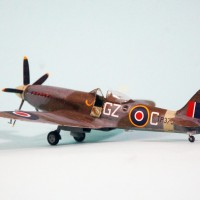
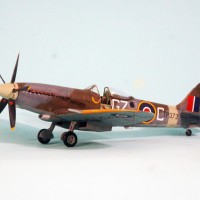
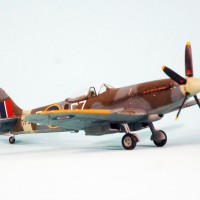



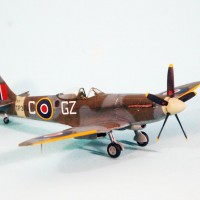
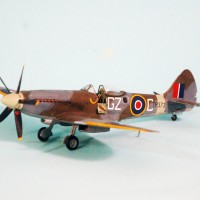
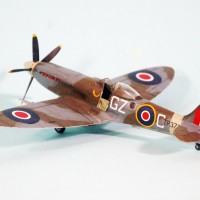
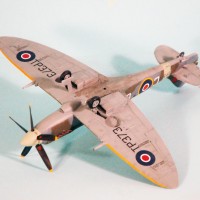


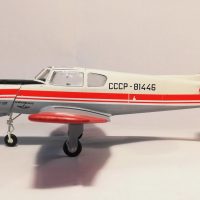
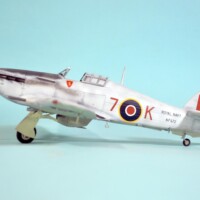
Beautiful build and comprehensive article Tom. Thanks for the warning about the kit, I've started looking for it.
P.S.: I think this work deserves better photos... 😉
"June Gloom" in Los Angeles means the light's not so good. Nice heavy overcast most of the day
Great job on a beautiful plane, Tom. I’ve started work on my two good kits and really like them. Frankly, I don’t understand criticisms of this kit that I’ve read elsewhere. I’ve seen a couple guys complaining about the fuel tank cover piece like it’s the end of the world. Both of mine seem to fit ok and will likely need a tiny bit of Mr. Surfacer when installed. Looking at it now, I think this was a clever way to represent that area which my eye is always drawn to on a Spitfire. I like the way they did the landing gear attachment and the shapes of the airframe look spot on to me. With regards to the QC issue, I’ve made contact with Airfix and they’re going to take care of me. Hopefully they tighten up the ship in that area.
Do you know anything about FR18 rocket stubs? I’m doing one kit as a 208 Sq. FR18 with clean wings, much like yours. However, just out of curiosity, I’m wondering about the stubs. Every photo I’ve seen of 208 birds shows them lacking the stubs. Were the stubs removable? Or were they built fixed to the wing at the factory and later removed at some point? Perhaps in Cyprus or Egypt? Nobody seems to discuss this issue. The FR18 was strengthened to take the rockets. The only other elliptical wing Spitfires to carry rockets were a small number of XVIs in 2AF at the end of WW2 experimentally modified to carry one under each wing.
I think one with ordnance is going to be the next kit release. The stubs were detachable. Only squadron I know of that used them and the rockets was 60 Squadron and you see photos of their airplanes with stubs and carrying rockets.
Thanks Tom. Yes you see pics of 60 Sq in Malaya with them.
the very first thing i saw this morning when i opened my eyes...very elegant build
Thanks Tom, you convinced me. After seeing a couple of derogatory review on the web I was going to sit this one out, despite the Mk.14 being a long-desired item. Then I read your description and saw one in the plastic last night at my local club and I'm off tomorrow to the big H(annants) in Hendon (London) to pick one up. Brilliant build and write up, as always, thanks.
Nice build and article Tom. Did some bubble top MkXIV's have the full span wing?
Many did. The FR XIV was clipped, some F.XIV were and some were not - check. Al FR 18s were full-span.
I’m pretty much on par with everything Tom, except the Indian production, as we’ve discussed. So that aside, I can see why you’ve built another one! I’m waiting for some decals to arrive, and then I’ll throw another one on the bench. In the meantime, my Hellcat should be coming in ?
What I find interesting about this release are the number of airframes that have survived the scrap yard. Having been stuffed and turned into gate guards or brought back from Burma or India. I used to visit the late Bob Ponds museum in Minnesota he had one in the collection. It seldom flew and prior to joining Ponds collection was painted up in bright red and was listed as G-Fire. It looks like a plane that would have flown at Reno. It makes sense for Airfix to make one of these kits since enough of them are around to be in the public view. "Aircraft in Focus" does a inventory/history of the various surviving Spitfires and the article shows a number of late model Spitfires. Another TC classic filled with history, modeling building ,enthusiasm and love of the hobby. Two thumbs up.
http://aircraft-in-focus.com/spitfire/
Great as always. I haven't got one yet. I'm currently building their Mk.Vb and have the Mk. I, the PR.XIX and the Seafire F.XVII to build. I just spent an outrageous amount of time trying to get the landing gear stubs attached to the wings
Great piece, Tom! I love Spitfires ... ALL of them.
However, I like reading about them (and others) because I always learn something interesting.
Thanks!
That is a beautiful bulild of, arguably, the most beautiful and purpose looking variant of the Spitfire. Few kits had me feeling anxious to obtain them, this is o e of them and your build surely is an inspiration!